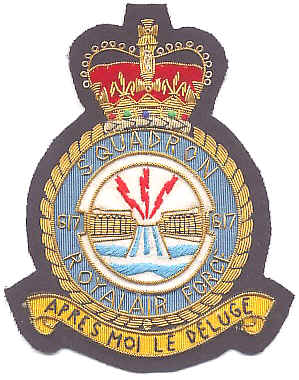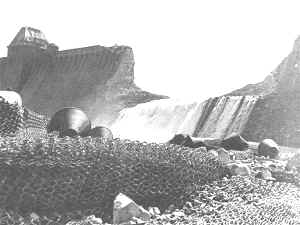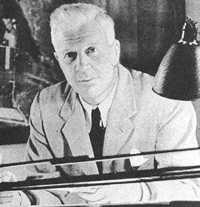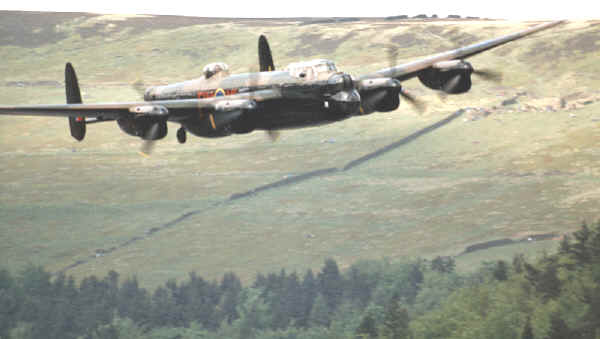 |
| Category: Air support |

|
|
|
|
|
|
The Dambusters; 617 Squadron
RAF but Australia was there |
 |
Very few
exploits of WW2 involve as much admiration as the raid on the German
dams of the Ruhr valley.
The famous and new 'bouncing"
bomb (mine)and the men who delivered them have become legend.
<<<
Current badge of 617 Sqn with their motto "Apres Moi Le
Deluge" (After Me The Flood)
Bomber Command Daily Report 18th
May 1943 Extract
WESTERN GERMANY
19 Lancasters of 5 Group were detailed
to attack the Moehne, Eder, Sorpe and Schwelm Dams. |
| MOEHNE
DAM. 5 Lancasters attacked at
0038-0049 hours, dropping 5 special mines. The attacks were reported
accurate and large water spouts, some of which caused water to over-run
the dam, marked the bursting charges. The first aircraft, in spite of
the accuracy of their attacks, did not apparently breach the dam; but
the fourth and fifth aircraft caused two adjacent breaches,
conservatively estimated to cover 30 yards of the dam, although the
depth of the breach was not seen. The formation commander observed that
water was pouring through the dam and the river below soon became
several times its original size for a distance of 3 miles downstream.
The Power House, situated immediately beneath the dam, completely
disappeared under the water.
EDER DAM.
3 Lancasters attacked between 0139-0156 hours, dropped 3 special mines,
2 aircraft report that their attacks were visibly successful, one
causing a hole about 30 feet below the top of the dam, and the other
making a gap about 9 feet wide on the Eastern side. A torrent of water
pouring through caused a tidal wave about 30 feet high to sweep down the
valley.
SORPE DAM.
2 Lancasters attacked at 0046 and 0314 hours, dropping 2 special mines.
The first aircraft reported that his attack caused the crown to crumble
over a distance of 15-20 feet and the second aircraft reported that
after his attack the dam was crumbling over a much greater distance. The
latter aircraft returned to the Moehne Dam and reported that water was
pouring through two large breaches in powerful jets.
SCHWELM DAM.
1 Lancaster attacked at 0337 hours, dropping 1 special mine without
visible results. This aircraft also visited the Moehne Dam and reported
difficulty in identifying this target which was obscured by a sheet of
water 7 miles long. Roofs of houses could be distinguished projecting
above the water which as flowing very fast.
The weather was good, there being
bright moonlight with some intermittent mist in the valley.
8 Lancasters are missing, three of
which are reported by radio transmissions to have attacked their
targets. There is day photographic confirmation of the effectiveness of
the attacks on Eder, Moehne and Sorpe dams. |
| SUMMARY OF INDIVIDUAL RESULTS |
| Aircraft |
Target |
Result |
| First Wave |
| G |
Moehne Dam |
|
| M |
" " |
Missing. Shot
down over target after attacking. |
| P |
" " |
- |
| A |
" " |
Missing. Dam
breached. |
| J |
" " |
2nd breach
made.

|
| L |
Eder Dam |
Small breach
made. |
| Z |
" " |
Missing.
Damaged by own mine which exploded on parapet of dam. |
| B |
Missing before
target was reached. Shot down near Dorsten. |
| N |
Eder Dam |
Large breach. |
| Second Wave |
| E and K |
Missing, one
at least before target was reached. |
| H |
Returned early
(flew too low over Zuider Zee, struck water and lost mine) |
| W |
Returned early
(hit by flak at Vlieland) |
| T |
Sorpe Dam |
Crown of dam
crumbled. |
| Third Wave |
| C |
Missing.
Detailed to attack Lister Dam, but no confirmation of the attack was
given. |
| S |
Missing before
reaching target. Exploded in mid-air near Tilburg. |
| F |
Sorpe Dam |
Top of dam
crumbled further. |
| O |
Schwelm Dam |
- |
| Y |
Detailed to
attack Lister Dam, which could not be found owing to mist in the
valleys. |
|
The Inventor of the
"bouncing" bomb, Barnes Wallis |
 |
The story of
617 Squadron began with the aircraft designer Barnes Wallis who when
hostilities began, was determined to make his personal contribution to
the war effort. He was acutely aware of the inability of existing
aircraft and weapons to carry out effective attacks on Germany's basic
sources of power and set about developing a series of weapons that were
to transform the meaning of air power.
He first tried to interest the Air
Staff in a ten ton 'earthquake' bomb of great penetration, but since no
existing aircraft were capable of carrying such a weapon, there was
understandable scepticism and a reluctance to risk diverting valuable
war effort. |
Since
considerable interest had been aroused by the possibility of breaching
the Ruhr Dams, Barnes Wallis then concentrated his attention on this
project. By experimenting with a model dam he found that a bomb capable
of carriage by the new Lancaster, would breech a dam the size of the
Moehne, provided it exploded immediately alongside the dam wall, below
the surface of the water. Anything like a torpedo was unsuitable, as it
was believed the Germans had anti-torpedo nets strung along the surface
of the lake. Further model tests proved that a bouncing bomb was
possible and so the go ahead was given. On 4 December 1942 the first
bouncing bomb was tested.
| Wallis
also either invented or helped invent the two most useful
non-nuclear bombs of WW2, the "Tallboy" and the
"Grand Slam" and the swing wing style of aeroplane
that led to the F111. |
|
|
|
| Diagram
showing how the bomb should work against a dam when fired from correct
altitude (60 feet) and speed (220 miles per hour) |
|
The Reasons and the Details |
The
great German Dams were vital to the industries of the Ruhr. They
provided hydroelectric power, water for cooling and other industrial
purposes, and also domestic water. In addition, if the dams could be
successfully breached a great deal of flood damage would result.
|
|
|
The Eder Dam
before the raid (above) and after (below) |
|
|
Briefly the operational plan was as
follows. Nine aircraft, led by Guy Gibson, were to attack the primary
target, the Moehne Dam. Once this had been breached they were to go and
attack the Eder Dam. A second wave of five aircraft was to fly directly
to the Sorpe Dam and attempt to breech it. Finally a third wave of five
aircraft was to act as reserve following behind the two waves.
On the night of 16 May 1943, only two
months since the formation of the Squadron nineteen specially modified
Lancasters, each carrying one of Barnes Wallis' bouncing bombs, took off
from Scampton and set course for Germany.
Of the nine aircraft comprising the
first wave, one was lost en-route and another whilst attacking the
Moehne Dam. When this dam had been successfully breached two aircraft
turned for home, whilst the remaining five, led by Gibson, flew on to
the Eder Dam which was breached at the cost of one more aircraft. On the
return journey another aircraft of the first wave was lost. Of the
second wave, two aircraft were compelled to abandon the sortie and two
more were lost en-route to the target, leaving only one of the original
five to attack the Sorpe Dam.
This it did with partial success, and
a portion of the dam wall was seen to crumble after the bomb had
exploded. The third wave was used to attack the Sorpe Dam again and also
secondary targets. Two aircraft of this wave were lost.
The operation was an outstanding
success but the cost had been high. Eight aircraft and fifty airmen
failed to return. Wing Commander Guy Gibson was awarded the Victoria
Cross and altogether thirty three of the aircrew were decorated for
their gallantry. Shortly after the raid the King and Queen visited the
squadron whilst at Scampton and approved the badge and motto - 'Apres
Moi Le Deluge'. |
|
The Lancaster's that carried
the "bouncing barrels bombs" |

|
|
A Lancaster flying
towards the dam at the 60th Anniversary (c) Tony
Cunnane 1993
|
|
|
| The "
bouncing barrel bomb" can be seen hanging below the belly of a
specially modified RAF Lancaster. |
|
The men who flew the
Lancasters |
|
|
|
|
|
The medals of Wing
Commander Guy Gibson VC DSO & bar DFC & bar |
|
The Aussies who were there |
|

|
|
| London, England.
1945-03-21. Portrait of the most
highly decorated Royal Australian
airman flying, 22 year old 407729 Flight Lieutenant David John Shannon
DSO and Bar DFC and Bar, of Bridgewater, SA, member of the Dambusters,
was one of nineteen Australian airmen who attended Buckingham Palace for
an investiture. |
|
|